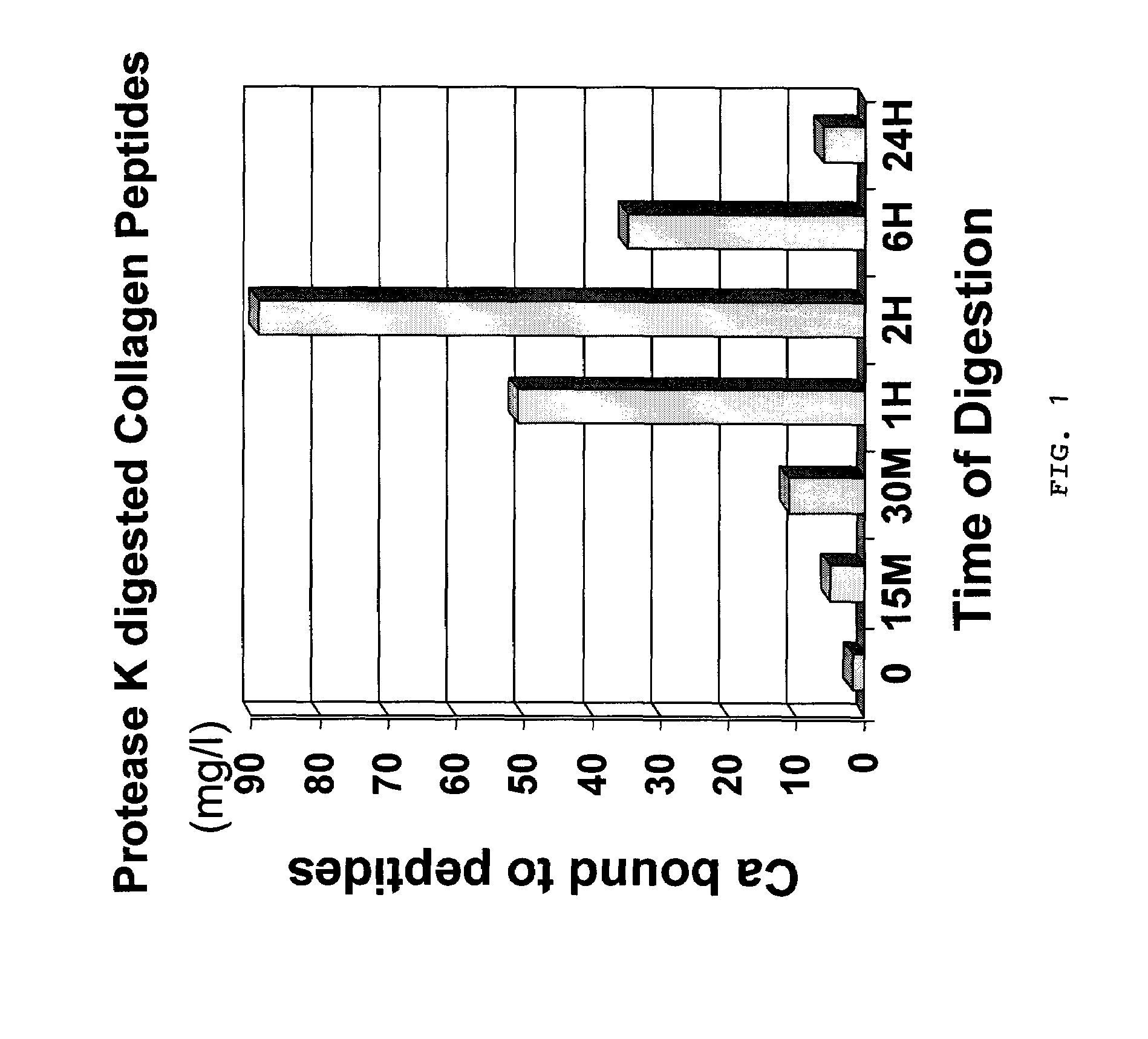Mineral collagen chelates and methods of making and using same
a technology of collagen chelate and minerals, which is applied in the field of dietary supplements, can solve the problems of affecting affecting the health of the body, and too little of one mineral can affect the action of others, and achieve the effect of maximizing its bioavailability
- Summary
- Abstract
- Description
- Claims
- Application Information
AI Technical Summary
Benefits of technology
Problems solved by technology
Method used
Image
Examples
experiment 1
[0026]Bovine hydrolyzed Collagen I / III powder with an average molecular weight of about 4 KD (obtained from AIDP, Inc. of City of Industry, CA), was made into a 500 mg / l solution in water and subjected to enzymatic treatment with Collagenase (catalogue # c5138 from Sigma, St. Louis, USA) at 1 mg / ml final concentration at 25° C. water bath with occasional mixing for various amounts of time to render different sized fragments as follows:[0027]Sample 1: Collagen I / III untreated[0028]Sample 2: Collagen I / III Collagenase digestion for 15 minutes[0029]Sample 3: Collagen I / III Collagenase digestion for 30 minutes[0030]Sample 4: Collagen I / III Collagenase digestion for 60 minutes[0031]Sample 5: Collagen I / III Collagenase digestion for 2 hours[0032]Sample 6: Collagen I / III Collagenase digestion for 24 hours
[0033]At the end of the treatment, samples were boiled for 5 minutes to stop the enzyme action and cooled to 22° C. in water bath. 100 ml of the digested samples were added to a beaker, mi...
experiment 2
[0038]The same procedures as experiment 1 were followed except that the enzyme Collagenase was replaced with Protease K from Sigma (Catalogue # p2308) at 100 ug / ml final concentration. Samples were treated at 25° C. as follows:[0039]Sample 1: Collagen I / III untreated[0040]Sample 2: Collagen I / III protease K digestion for 15 minutes[0041]Sample 3: Collagen I / III protease K digestion for 30 minutes[0042]Sample 4: Collagen I / III protease K digestion for 60 minutes[0043]Sample 5: Collagen I / III protease K digestion for 2 hours[0044]Sample 6: Collagen I / III protease K digestion for 6 hours[0045]Sample 7: Collagen I / III protease K digestion for 24 hours
[0046]Calcium binding assay were carried out as in experiment 1. Results were as follows:
[0047]
Soluble Ca (Calcium bound to peptides)Sample #(mg / l)Sample 11.74Sample 2.5.045Sample 3.11.19Sample 4:50.96Sample 5:89.07Sample 6:34.94Sample 7:6.284
[0048]Based on the results and as further shown in FIG. 1, maximum binding of calcium occurred at a...
##ic example 1
Prophetic Example 1
[0052]Commercially available collagen I / III from bovine skin is placed in a large tank with water and protease enzymes including, but not limited to Pancreatin, Bromelain, papain, or a mixture of these enzymes under stirring conditions. The digestion conditions are monitored to produce the collagen hydrolysate to average molecular weight between 1-2 KD with MS—HPLC and / or appropriately-sized filters selected to separate collagen fragments of a desired size. The enzymes are inactivated and the solution is filtered. To the filtered solution, a soluble mineral source such as calcium carbonate is added, the mixture is stirred for several hours, and pH is adjusted to 8.5 with NaOH to form a precipitate. The mixture, sprayed dry in a powdered form, contains about 15% of Calcium with average molecular weight 1-2 KD.
PUM
| Property | Measurement | Unit |
|---|---|---|
| concentration | aaaaa | aaaaa |
| concentration | aaaaa | aaaaa |
| concentration | aaaaa | aaaaa |
Abstract
Description
Claims
Application Information
 Login to View More
Login to View More - R&D
- Intellectual Property
- Life Sciences
- Materials
- Tech Scout
- Unparalleled Data Quality
- Higher Quality Content
- 60% Fewer Hallucinations
Browse by: Latest US Patents, China's latest patents, Technical Efficacy Thesaurus, Application Domain, Technology Topic, Popular Technical Reports.
© 2025 PatSnap. All rights reserved.Legal|Privacy policy|Modern Slavery Act Transparency Statement|Sitemap|About US| Contact US: help@patsnap.com

